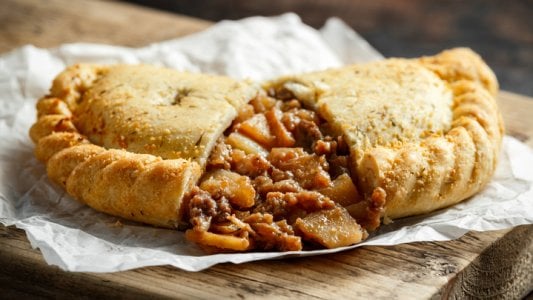Scrumptious homemade Cornish pasties
- Replies 4
Here's a fun fact about Cornish pasties you may not know: According to Wikipedia, the hallmark side-crimping isn't for aesthetic purposes, but rather for hygiene. As Cornwall had a large mining industry, it's believed that miners might have eaten the pasty holding the thick edge of pastry, which was later discarded, thereby ensuring that dirty fingers (possibly including traces of arsenic) did not touch the food or mouth.
Ingredients:
Pastry:
2 cups (260 grams) of all-purpose flour
1 teaspoon salt
3/4 teaspoon baking powder
¼ cup (60 grams) vegetable shortening
¼ cup (60 grams) butter
3 tablespoons cold water
1 egg, beaten
Filling:
200 grams ground beef
200 grams ground pork
1 medium potato, thinly sliced
1 small onion, finely chopped
1 small carrot, peeled and grated
1/4 teaspoon salt
1/4 teaspoon black pepper
Instructions:
1. Preheat oven to 375 degrees F (190 degrees C).
2. In a medium bowl, combine flour, salt, and baking powder. Cut in shortening and butter until mixture resembles coarse crumbs. Gradually add cold water, tossing with a fork until a firm dough is formed.
3. On a lightly floured surface, knead dough for about 8 minutes. Then divide into four and chill for 20 minutes.
4. Roll each piece of dough on a lightly floured surface to make a circle around 20cm across.
5. In a large bowl, combine ground beef, ground pork, potato, onion, carrot, salt and pepper.
6. Place ¼ of the filling in the centre of each dough circle and brush the edges with beaten egg.
7. Bring up the edges of the dough circle, and crimp together to form a seal.
8. Place pasties on a greased baking sheet.
9. Combine egg and milk; brush over pasties.
10. Bake at 375 degrees F (190 degrees C) for 40-45 minutes until golden brown.
P.S: Did you know that the term "Cornish pasty" was given protected status by the European Commission back in 2011? That means that legally speaking, only pasties made in Cornwall from a traditional recipe can now be called "Cornish pasties", much like sparkling wine can only be called ‘Champagne’ if it’s made in that particular region of France.
Let us know if you give this recipe a go. For those of you who prefer video recipes, take a look at this (slightly different) one below:








